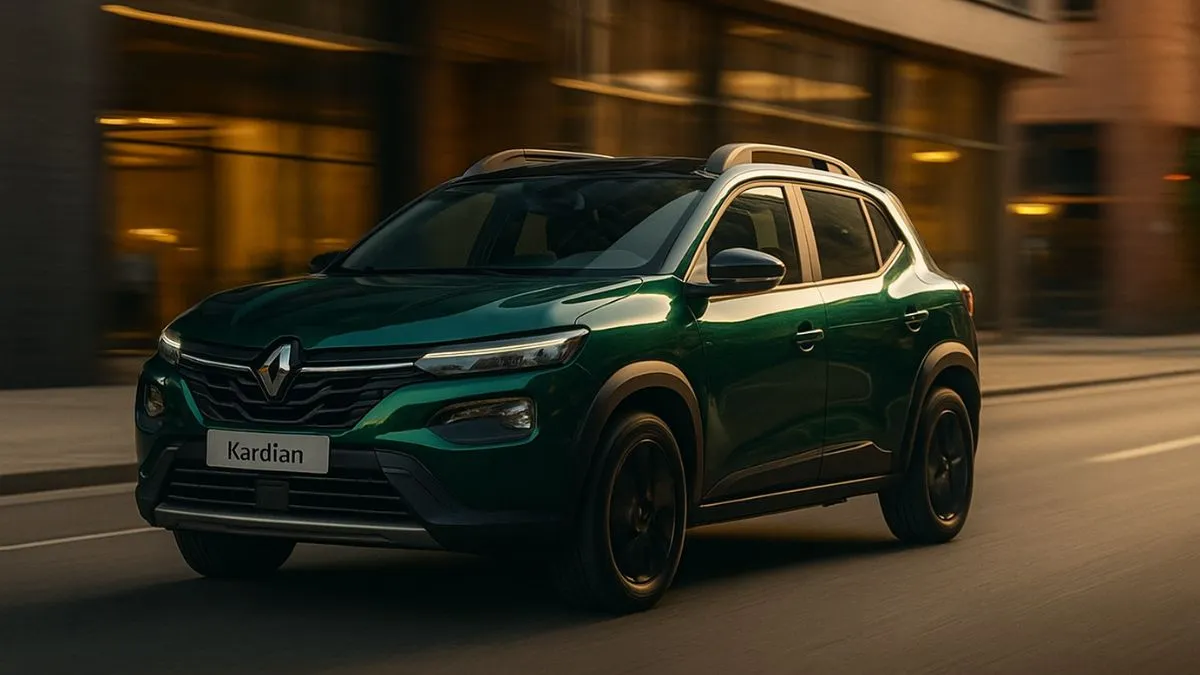Renault currently offers good options like the Kiger, Kwid, and Triber in India, but tech-savvy buyers are searching for a more updated B2-segment SUV packed with next-gen features.
In global markets, the Renault Kardian has already made its mark — winning hearts with a powerful turbo engine, ADAS features, and a futuristic design.
In this blog, you’ll get all the raw and verified details about the Renault Kardian — from its exterior and engine to features, ride quality, and the possibility of an India launch.
Also, read this: Mahindra XUV 3XO Base Model 2025 Launched at ₹7.49 Lakh
Exterior Design & Build
The Renault Kardian is built on a brand-new RMP platform, designed specifically for emerging markets. The SUV measures 4,120 mm in length and offers a ground clearance of around 209 mm — meaning you don’t have to fear potholes or speed breakers.
Its sharp LED DRLs, split headlamp design, and 17-inch diamond-cut alloy wheels give it more of an urban warrior vibe than just a regular SUV. Side body cladding, a muscular profile, and signature C-shape tail lamps at the rear complete the look.
With modern boldness in design and a genuine SUV feel, the Kardian is globally considered “glamorous yet rugged.”
Also, read this: Luxury-like Maruti Alto 800 Arrived at ₹3 Lakh!
Engine & Performance
The Kardian is powered by a new 1.0-litre 3-cylinder turbo petrol engine that delivers approximately 120–125 PS of power and 220 Nm of torque. Despite its compact size, this sub-compact SUV offers a punchy and heavy performance.
The engine is paired with a 6-speed dual-clutch automatic (DCT) gearbox — ensuring buttery smooth gear shifts. It also offers three drive modes – Eco, Sport, and MySense – so there’s a setting for every mood.
Renault Kardian vs Rivals – Engine Specs
| SUV Model | Engine Type | Power (PS) | Torque (Nm) | Gearbox |
| Kardian | 1.0L Turbo Petrol | 120–125 | 220 | 6-speed DCT |
| Renault Kiger | 1.0L Turbo Petrol | 100 | 160 | CVT / MT |
| Tata Nexon | 1.2L Turbo Petrol | 120 | 170 | AMT / DCT |
| Hyundai Venue | 1.0L Turbo Petrol | 120 | 172 | iMT / DCT |
Acceleration & Top Speed
Exact acceleration figures aren’t available, but according to international sources, its top speed could go up to around 180 km/h.
Compared to existing models like the Kiger, the Renault Kardian vs Kiger comparison shows that Kardian is more responsive and quicker — making it a strong performer on highways.
Mileage & Fuel Economy
Since the Kardian hasn’t launched in India yet, ARAI mileage figures are not available. However, based on global test results, the turbo petrol + DCT combo is expected to deliver around 18–20 km/l.
This could be slightly lower on Indian roads but is still considered impressive for a turbocharged engine.
Comfort & Space
The Kardian is a 5-seater B2-segment SUV, but its interior is designed with practical space utilization in mind.
With an all-black theme, contrast stitching, a flat-bottom steering wheel, and a joystick-style gear shifter, it offers a sporty and modern cabin vibe. Rear seats provide ample legroom and headroom, making it feel spacious for urban families.
Features & Tech
The Kardian brings in connected car features that could set a new benchmark in its segment:
- 8-inch touchscreen with wireless Apple CarPlay & Android Auto
- 7-inch digital driver display
- Paddle shifters
- Ambient lighting (8-color)
- Wireless charging and auto AC
It stands out with 6 airbags, ESC, an electronic parking brake, and a 360° camera.
More impressively, it offers 13 ADAS features like:
- Adaptive Cruise Control
- AEB (Autonomous Emergency Braking)
- FCW (Forward Collision Warning)
- Blind-Spot Warning
- Lane Keep Assist
These features are still missing in many Indian SUVs, including some priced higher.
Renault Kardian Key Features Table
| Category | Feature Highlights |
| Infotainment | 8″ touchscreen, wireless Apple CarPlay, Android Auto |
| Driver Display | 7″ digital cluster, paddle shifters |
| Comfort | Ambient lighting, joystick shifter, auto AC |
| Safety & ADAS | 6 airbags, ESC, 360° camera, 13 ADAS features |
Ride Quality, Suspension & Handling
Limited reviews from global markets suggest that the Kardian’s ride quality is quite refined. While the suspension setup is somewhat similar to the Kiger, it has noticeable improvements.
Both high-speed stability and body roll control have received praise. For Indian terrains, some tuning might be done to enhance comfort and stability.
Price, Variants & Value
Renault hasn’t officially announced an Indian launch, but the expected Renault Kardian India launch date is around 2026.
If priced around ₹10–12 lakh (ex-showroom), it will directly compete with:
- Tata Nexon
- Maruti Brezza
- Hyundai Venue
- Kia Sonet
- Maruti Fronx
If launched at this price point, it would easily qualify as one of the best SUVs under ₹12 lakh, offering more power and tech than its rivals.
Expected Renault Kardian Variants & Pricing (India)
| Variant | Expected Price (₹ Lakh) | Key Highlights |
| Base | ₹10.0 | Turbo engine, Touchscreen |
| Mid | ₹11.0 | Wireless charging, 6 airbags |
| Top | ₹12.0 | ADAS, 360° camera, DCT gearbox |
For more information, visit the official website Renault Kardian
Conclusion
The Renault Kardian is a global-ready SUV — featuring a powerful turbo engine, a new modular platform, connected features, and advanced ADAS tech.
If launched in India by 2026, it could become one of the most exciting 2026 upcoming SUVs in India, and redefine the value proposition in the under-₹12 lakh segment.
For now, Renault India’s strategy around the Kardian remains unclear — but with the Duster and Bigster expected to make a comeback, the Kardian feels like a logical next step.
If you’re waiting for an SUV that takes tech, comfort, and style to the next level — the Renault Kardian could truly be a game-changer.
FAQ: Renault Kardian
What is the expected launch date of Renault Kardian in India?
The Renault Kardian is expected to launch in India by early or mid-2026, although no official confirmation has been made.
How does Renault Kardian compare to the Kiger?
The Kardian offers more power, tech, and safety features than the Kiger, making it a better value proposition.

